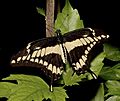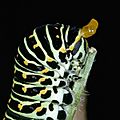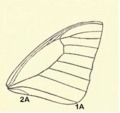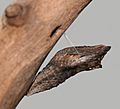Swallowtail butterfly facts for kids
Quick facts for kids Swallowtail butterfly |
|
|---|---|
 |
|
| Papilio machaon | |
| Scientific classification |
|
| Kingdom: | Animalia |
| Phylum: | Arthropoda |
| Class: | Insecta |
| Order: | Lepidoptera |
| Superfamily: | Papilionoidea |
| Family: | Papilionidae Latreille, [1802] |
| Type genus | |
| Papilio Linnaeus, 1758
|
|
| Subfamilies and genera | |
|
There are 31 genera and about 600 species:
|
|
Swallowtail butterflies are large, colorful butterflies that belong to the family Papilionidae. There are at least 550 different species of swallowtails. Most of them live in warm, tropical places, but you can find them on every continent except Antarctica. This family also includes the biggest butterflies in the world, like the birdwing butterflies from Australia.
Contents
Where Swallowtail Butterflies Live
There are over 550 types of swallowtail butterflies known today. They live all over the world in both warm and mild climates. You can find them from sea level up to very high mountains. For example, some Parnassius species live high up in the mountains.
Most kinds of swallowtails live in warm, tropical areas, especially in Southeast Asia. Only a few species are found in Europe. In North America, there are about 40 species, including some tropical ones.
The swallowtail that lives furthest north is the Siberian Apollo (Parnassius arcticus). It can be found in the Arctic Circle in northeastern Yakutia, living at heights of 1,500 meters (about 5,000 feet). In the Himalayas, some Apollo species have been seen as high as 6,000 meters (nearly 20,000 feet) above sea level!
What Swallowtails Eat
Swallowtail caterpillars eat many different kinds of plants. Most of them depend on plants from just a few families, like Aristolochiaceae, Annonaceae, Lauraceae, Umbelliferae (like carrots), and Rutaceae (like citrus).
Some of these plants are toxic. When the caterpillars eat them, they store the plant's toxins, like aristolochic acid, in their bodies. This makes both the caterpillars and the adult butterflies toxic to predators. For example, the Parnassius smintheus caterpillar gets a protective chemical from the Sedum lanceolatum plant.
Certain groups of swallowtails almost only eat plants from the Aristolochiaceae family. For instance, the Eastern Black Swallowtail caterpillar mainly eats Queen Anne's Lace in the wild. But they also enjoy garden plants from the carrot family, such as carrots, parsley, dill, and fennel.
Adult swallowtail butterflies mostly drink nectar from flowers. They also sometimes drink from mud puddles or even animal waste to get important minerals.
The Swallowtail Life Cycle
Like all butterflies, swallowtails go through four main stages in their life cycle.
- Egg: The eggs are shaped like a dome, not as tall as they are wide. They are usually smooth and feel a bit leathery.
- Larva (Caterpillar): The caterpillar is thick and can be smooth or have fleshy bumps on its back. Some have a raised bump on their fourth body segment. A special organ called an osmeterium is found on the second segment. When the caterpillar feels threatened, it can push out this forked, fleshy organ. It gives off a strong, not-so-nice smell to scare away predators.
- Pupa (Chrysalis): The pupa can look different depending on the species. Often, it curves backward and has angles. It attaches itself by its tail, usually hanging straight down. It's also held in place by a silken thread around its middle. However, Parnassius pupae are found in a loose silk web among leaves.
- Imago (Adult Butterfly): Adult swallowtails have wings that vary a lot in shape. The hindwing (back wing) often has a "tail" that can be thin or wide. This tail is an extension of a specific part of the wing. In one genus, Armandia, the hindwing has tails at three different spots.
Stages of development of a papilionid, the giant swallowtail (Papilio cresphontes)
Special Features of Swallowtails
Swallowtail butterflies have a few unique features that set them apart from other butterfly families:
- The osmeterium is a special, forked organ that caterpillars can push out from their neck area. It's used for defense.
- Wing Veins: In swallowtails, a specific wing vein (called 2A) goes all the way to the edge of the wing. In other butterfly families, this vein joins with another vein and doesn't reach the edge.
- Neck Structure: The hard plates (sclerites) in their neck area are joined together under the neck. This is where the muscles that move their head are attached.
Clever Defenses and Adaptations
Swallowtail butterflies use a clever trick called Batesian mimicry. This means they look very similar to other species that taste bad or are poisonous to predators. By looking like these dangerous butterflies, they avoid being eaten.
For example, the female Tiger Swallowtail butterfly (Papilio glaucus) can have different appearances. Some females look like a bad-tasting butterfly, while others don't. This is a type of polymorphism, where a species has different forms. However, other swallowtails, like the Canadian Tiger Swallowtail (Papilio canadensis), don't use mimicry.
Swallowtails have many predators, including birds like the red-winged blackbird, various insects like the Pennsylvania firefly and Chinese mantis, and even small animals like the five-lined skink and striped skunk.
See also
 In Spanish: Papiliónidos para niños
In Spanish: Papiliónidos para niños










